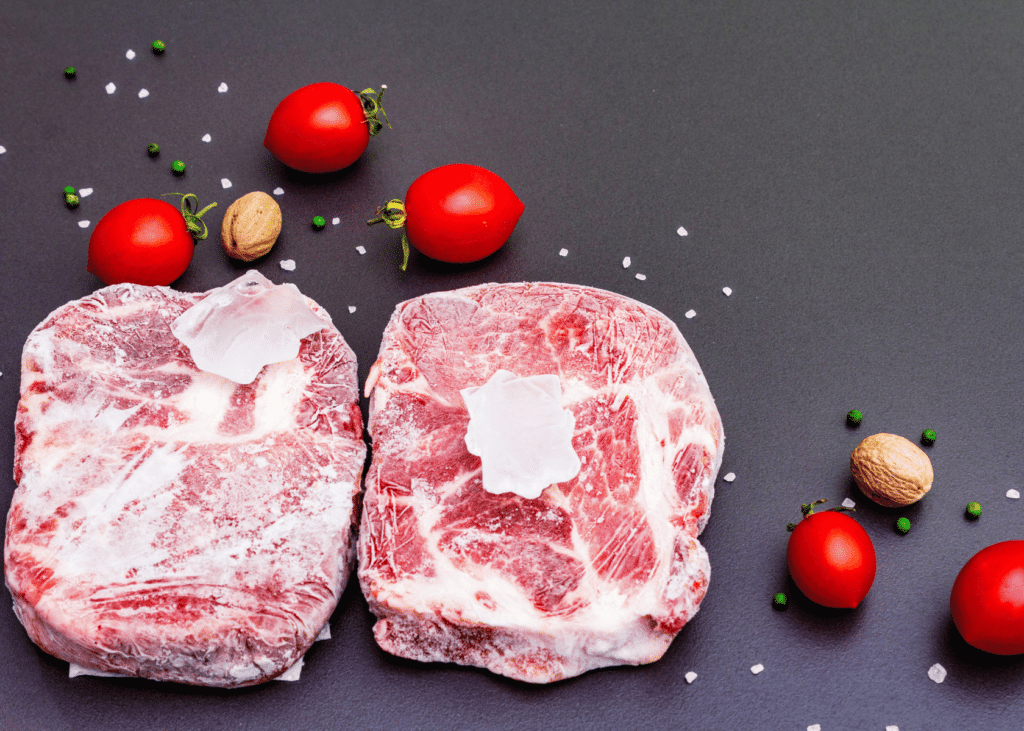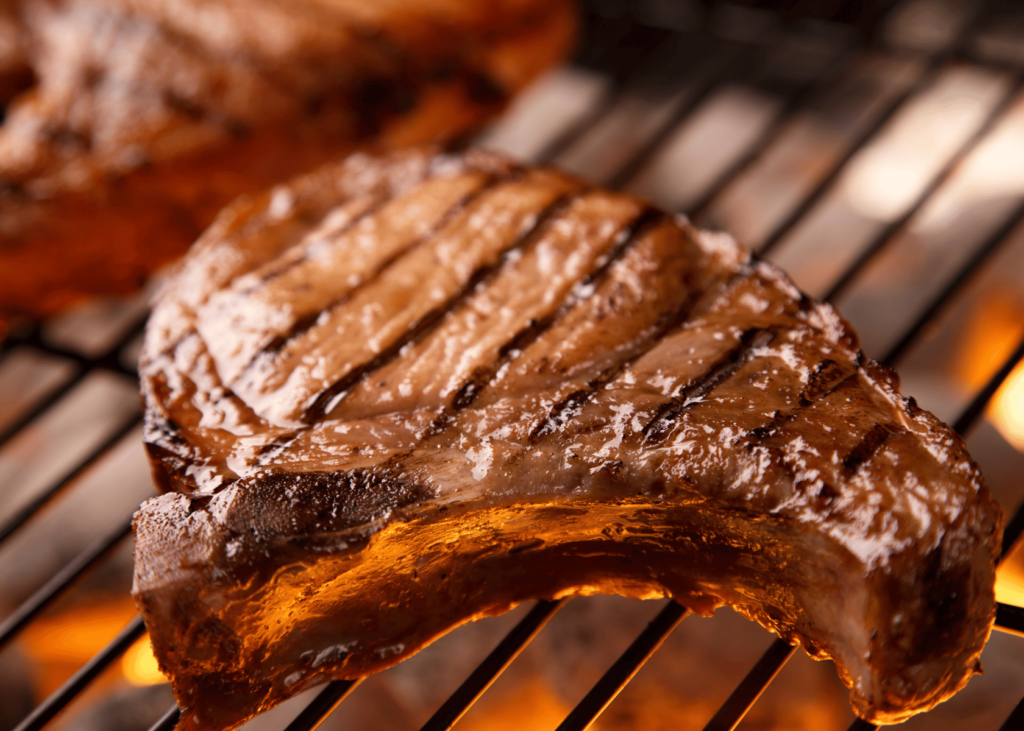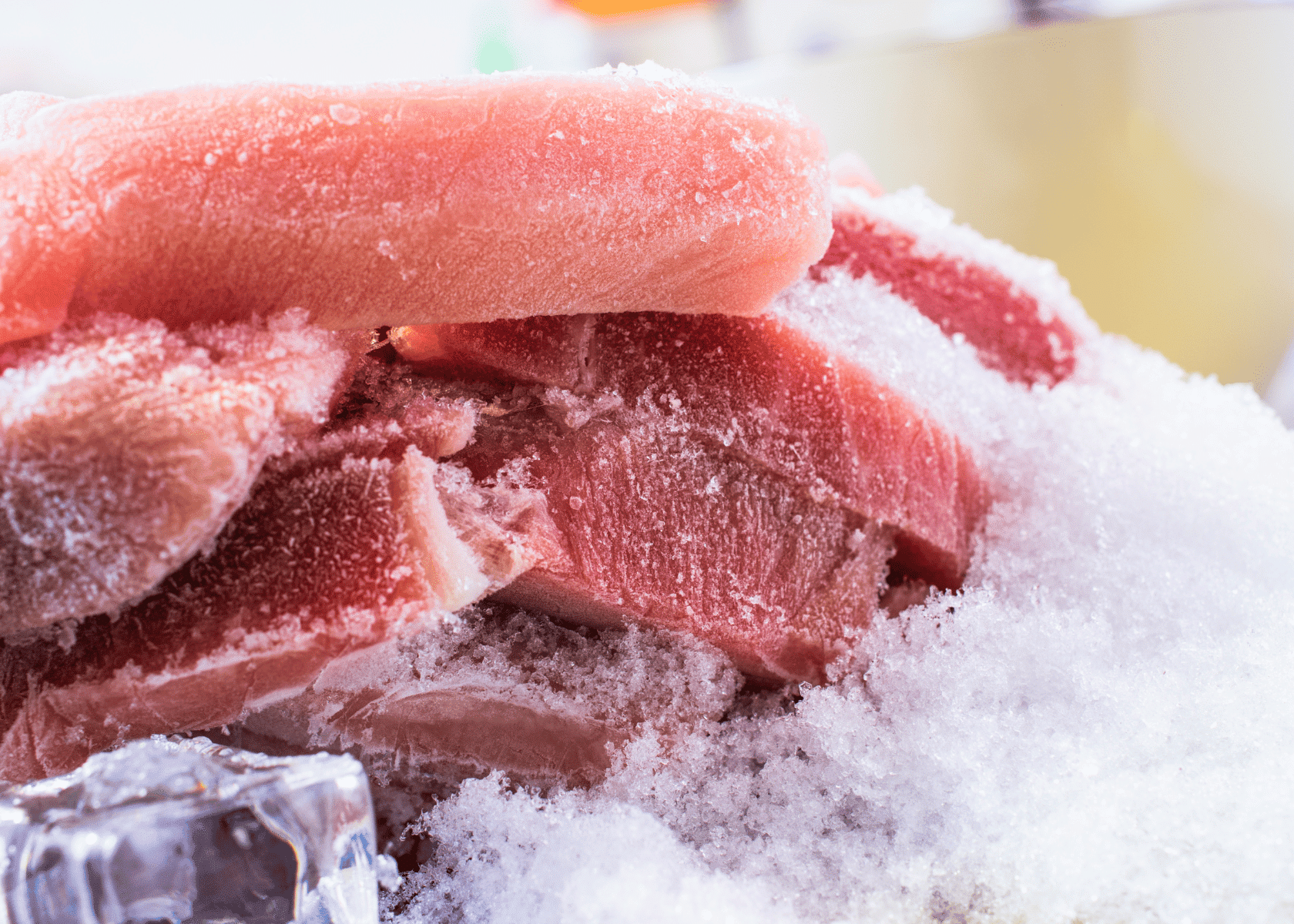Can you grill frozen steak? The simple answer is yes! Gone are the days of waiting hours for your steak to thaw before firing up the grill. Grilling frozen steak can not only offer convenience. However, it also results in a better flavor and moisture retention compared to fresh cuts.
But there’s more to it than just tossing a slab of icy meat onto the heat! Keep reading as we dive into the pros, cons, and best practices for grilling frozen steak like a pro.
Key Takeaways
- Grilling frozen steak is possible and can result in a more flavorful and juicy meat.
- However, there are some risks to consider such as uneven cooking and potential bacteria growth. It’s important to use proper seasoning, preheat the grill correctly, monitor the internal temperature with a food thermometer, and handle and store the meat properly.
- If you prefer to thaw your steak before grilling, there are different methods like refrigerator thawing or cold water thawing that can ensure safe consumption.
Grilling Frozen Steak: Pros And Cons
Grilling frozen steak has its advantages. These include convenience and moisture retention, but it also poses risks of uneven cooking and potential bacteria growth.
Convenience And Moisture Retention
One of the undeniable benefits of grilling frozen steak is the sheer convenience it offers. Imagine being able to cook a delicious grilled steak for dinner straight from your freezer, without having to wait hours for it to thaw! This saves both time and effort, especially when you’re craving a tasty meal without much notice.
Aside from convenience, cooking frozen steaks can actually help retain moisture within the meat. As the exterior sears quickly on high heat due to its frozen state, ice crystals inside rapidly convert into steam. This creates an environment where more juices are locked into the beef fibers rather than evaporating away during the cooking process.
The result? A satisfyingly juicy and tender bite that may just outshine traditionally-cooked fresh steaks.
Risk Of Uneven Cooking And Bacteria Growth
Grilling frozen steak can be a convenient option, but it does come with some risks. One of the main concerns is uneven cooking. The outside of the steak may become charred while the inside remains raw if not properly cooked.
This is because frozen meat takes much longer to cook than fresh meat due to its low temperature.
Another risk associated with grilling frozen steak is bacteria growth. When meats are left out at room temperature for too long, harmful bacteria can grow rapidly and cause foodborne illnesses.
If you plan on grilling frozen steak, make sure that you keep it in the freezer until just before grilling, and do not leave it sitting outside for an extended period of time before cooking.
By taking proper precautions when grilling frozen steak, you can enjoy a tasty meal without worrying about safety issues or unevenly cooked meat.
Tips For Grilling Frozen Steak
Properly preheating the grill, using indirect heat, seasoning and spices, as well as cooking time and temperature are all crucial tips for grilling frozen steak.
Properly Preheating The Grill
Before grilling frozen steak, it’s crucial to properly preheat your grill. This step ensures that the grill is hot enough to sear the steak and cook it evenly. For a gas grill, turn on all burners to high heat and close the lid for 10-15 minutes.
It’s important not to rush this step or start cooking too soon. A properly heated grill will create beautiful char marks on your steak while keeping it juicy inside. Skipping this step can result in uneven cooking, leading to raw or burnt spots on your meat.
Using Indirect Heat
One effective way to grill frozen steak is by using indirect heat. This method involves creating two temperature zones on your grill. One zone with high heat and another with low or no heat.
Start by preheating your grill to high for about 15 minutes, and then turn off one side of the burners or move the charcoal away from one side. Place the frozen steak on the cooler side of the grill and let it cook slowly until it reaches an internal temperature of at least 125°F for rare or up to 160°F for well-done, depending on preference.
Don’t forget to add some seasoning or spices such as garlic powder, salt, black pepper, paprika, onion powder before grilling your frozen steak using indirect heat for added flavor.
Always keep an eye on your meat’s internal temperature when grilling frozen steak and make sure that it reaches a safe temperature before serving, as advised in [IMPORTANT FACTS].
Seasoning And Spices
Adding seasoning and spices to frozen steak before grilling is essential in creating a delicious and flavorful meal. The best way to season frozen steak is by letting it thaw partially, so the seasoning can penetrate the meat.
Alternatively, you can season directly onto the frozen surface before placing it on the grill. A variety of spices such as garlic powder, chili flakes, smoked paprika, or rosemary work well with most cuts of steak.
Using marinades is another option for adding additional flavor to your grilled steaks; however, ensure that they are not overly acidic as high acidity may affect meat texture when grilling.
After seasoning or marinating your frozen steaks properly, let them sit at room temperature for about ten minutes before grilling to allow better absorption of flavor and even cooking.
Cooking Time And Temperature
Grilling frozen steak requires some adjustments to the usual cooking time and temperature due to the nature of frozen meat. Here are some tips for ensuring your steak is cooked to perfection:
- Preheat the grill to a high temperature, around 450 – 500 degrees Fahrenheit, before adding the frozen steak.
- Use indirect heat by turning off one burner on a gas grill or moving the coals to one side on a charcoal grill. This allows the steak to cook more evenly without burning.
- Cook thicker cuts of frozen steak for longer than you would defrosted steaks. For example, a one-inch thick frozen ribeye will take approximately 20-25 minutes total cooking time compared to 12-15 minutes for a defrosted steak.
- Monitor the internal temperature of the steak with a meat thermometer. Aim for an internal temperature of 130 degrees Fahrenheit for medium-rare and 140 degrees Fahrenheit for medium.
- Let the grilled frozen steak rest before serving to allow the juices to distribute evenly throughout the meat. A good rule of thumb is to let it rest for at least five minutes before slicing into it.
By following these cooking time and temperature guidelines, you can enjoy a delicious grilled frozen steak that’s cooked evenly and safe to eat.
Ensuring Safe Consumption Of Grilled Frozen Steak

Use a food thermometer to check the internal temperature of the steak, and make sure it reaches at least 145°F before serving.
Importance Of Using A Food Thermometer
Using a food thermometer is crucial when it comes to grilling frozen steak. Since the interior of the steak takes longer to cook, it’s essential to ensure that the meat has reached a safe internal temperature before consuming.
The USDA recommends cooking beef steaks and roasts to an internal temperature of 145°F (63°C) with a three-minute rest time before carving or consuming. By using a meat thermometer, you can take the guesswork out of cooking your steak and make sure that it’s not only flavorful but also safe to eat.
In addition, if you’re cooking for guests who prefer their steak cooked differently than you do, using individual thermometers can help ensure everyone’s preferences are met without sacrificing food safety.
Checking Temperature And Letting The Steak Rest
After grilling frozen steak, it’s important to check the internal temperature before serving. Using a meat thermometer is essential in ensuring that the steak has reached a safe cooking temperature of 145°F for medium-rare, 160°F for medium, and 170°F for well-done.
Avoid cutting into the steak immediately as this can cause juices to escape and result in dry meat. Instead, let the steak rest for several minutes before slicing into it.
It’s also crucial to handle cooked steak properly by storing leftovers promptly at safe temperatures (below 40°F) and reheating them thoroughly before consuming them again.
Proper Handling And Storage
It’s important to handle and store frozen steak properly to ensure safe consumption. When preparing frozen steak, make sure to wash your hands before and after handling the meat.
Use separate cutting boards and utensils for raw meat to avoid cross-contamination with other foods.
When storing frozen or leftover cooked steak, keep it in an airtight container or freezer bag to prevent freezer burn and contamination. You can freeze cooked steak for up to six months if stored properly.
By following these proper handling and storage techniques, you can safely enjoy delicious grilled frozen steaks without worrying about foodborne illnesses or spoilage.
Alternatives To Grilling Frozen Steak
There are several alternatives to grilling frozen steak, including thawing methods, sous vide cooking, and pan-searing techniques.
Thawing Methods
Thawing frozen steak can be done in several ways to ensure even cooking and safe consumption. Here are some methods:
- Refrigerator Thawing: Place the frozen steak on a plate or tray and put it in the refrigerator for about 24 hours. This will allow the steak to thaw slowly and help retain its moisture.
- Cold Water Thawing: Put the frozen steak in a sealed plastic bag and submerge it in cold water for 30 minutes per pound of meat, changing the water every 30 minutes. This method is faster than refrigeration but requires more attention.
- Microwave Thawing: Use your microwave’s defrost setting to thaw the frozen steak. Be sure to rotate and flip the steak frequently to prevent uneven cooking.
- Sous Vide Thawing: Place the frozen steak in a vacuum-sealed bag and immerse it in a sous vide water bath set at 120°F for several hours until fully thawed.
Regardless of which method you choose, be sure to cook your thawed steak within two days of thawing it to ensure freshness and safety.
Sous Vide Method
One alternative to grilling frozen steak is the sous vide method. This involves placing the frozen steak in a plastic bag and cooking it in a water bath at a precise temperature for an extended period.
To use this method, you’ll need a sous vide machine, which can be purchased at most kitchen supply stores or online retailers. Simply season the frozen steak with your desired spices and place it in a vacuum-sealed bag.
While this method may take longer than grilling directly from frozen, some people prefer its consistency and convenience. Plus, there’s less risk of uneven cooking or bacteria growth compared to grilling straight from frozen.
Pan-Searing Technique
A pan-searing technique is a great alternative to grilling frozen steak. This method involves cooking the steak in a hot skillet with minimal oil or butter. One advantage of this technique is that it allows for greater control over the cooking process and ensures even heat distribution, resulting in a deliciously seared crust and juicy interior.
To pan-sear frozen steak, simply heat your skillet on high until it’s very hot. While waiting for the skillet to heat up, season the steak generously with salt and pepper or any preferred seasoning mix.
Once the skillet is hot enough, add a small amount of oil then carefully place the steak into the pan, allowing each side to cook for about 3-5 minutes depending on thickness and desired doneness.
Make sure not to overcrowd your pan as it may cause uneven cooking.
Whether you choose to grill or pan-sear your frozen steaks, remember always to use safe food handling techniques and ensure that they reach an internal temperature of at least 145°F before serving.
Grilling Techniques For Perfectly Cooked Steak

Direct grilling involves searing the steak directly over high heat, while indirect grilling is when the meat is cooked with a lower heat and not placed directly over the flames.
Direct Grilling
It is a popular grilling technique where food is cooked directly over the heat source, typically using high temperature and short cooking times. This method is ideal for thinner cuts of steak such as sirloin or flank steak, and can be used to achieve those coveted grill marks that make your steak look picture perfect.
When direct grilling frozen steak, it’s important to ensure that the grill has been preheated properly before placing the meat on top.
It’s important to note that thicker cuts of frozen steak may not cook evenly through direct grilling alone, so it may be necessary to use indirect heat in combination with this technique.
Indirect Grilling
Another technique for grilling frozen steak is indirect grilling. This method involves cooking the steak on a cooler part of the grill, away from the direct heat source. Indirect grilling works well for thicker cuts of steak that need additional cooking time.
To cook using indirect heat, you’ll want to preheat one side of your grill and then move the meat to the cooler side once it reaches desired temperature. This will allow the meat to continue cooking without getting charred or burned by direct flames.
Overall, indirect grilling can help ensure that your frozen steak is cooked evenly throughout while still retaining its natural juices and flavor.
Searing
Searing is an essential technique in grilling frozen steak, as it helps to lock in the juices and flavors while creating a crispy outer layer. To achieve the perfect sear, start by preheating your grill to medium-high heat and brushing the frozen steak with oil or melted butter.
Place the steak directly on the hot grates and leave it for 2-3 minutes until you see grill marks forming.
Keep in mind, however, that searing shouldn’t be done for too long as it can result in uneven cooking or burnt edges. Once you have achieved a good sear, switch your grill to indirect heat and continue cooking until your desired doneness is reached.
Choosing The Right Cut Of Steak
The cut of steak you choose can make a significant difference in the overall flavor and tenderness of your grilled meal. Some popular cuts for grilling include T-bone, ribeye, and porterhouse steaks., Each of these cuts offers a unique balance between fat content and tenderness.
It’s also essential to consider the thickness of the cut when selecting a steak for grilling. A thicker cut provides more leeway when cooking frozen steak since it takes longer to cook through completely.
Additionally, it’s wise to choose a flat-shaped frozen steak as opposed to one with curves or uneven edges that could result in uneven grill marks or inconsistent cooking times.
Frequently Asked Questions:
1. Can you grill frozen steak directly from the freezer?
You can technically grill a frozen steak, but it is highly recommended to thaw the steak first. This will help you ensure even cooking and better flavor.
2. How long does it take to thaw a frozen steak?
The time it takes to thaw a frozen steak will depend on its size and thickness. It is best practice to allow 24 hours of refrigerator-thawing time for every five pounds of meat. Alternatively, you can also use the cold water method by placing the wrapped steak in cold water for several hours until sufficiently defrosted.
3. Is there any difference between grilling fresh versus previously-frozen steaks?
Cooking times vary depending on whether your cut was previously-frozen or not as this affects moisture content & ice crystal structure within cells – which ultimately impacts texture/density/cooking temps required when grilling/frying/etc. Fresh steaks typically cook faster than their previously-frozen counterparts because they have lower moisture content, but both options are delicious if handled properly during preparation!
4. Should I season my frozen steak before grilling?
It is important to wait until after your frozen steaks are fully thawed/mostly defrosted before seasoning them so that the salt/seasonings penetrate into all portions evenly (otherwise flavors might end up uneven). Thawed steaks should always room-temperature rest at least 30 mins with seasoning applied prior to applying heat as well in order optimally absorb flavors while retaining desired consistency!
Conclusion
In conclusion, grilling frozen steak is possible and can even produce better results than cooking fresh meat. However, there are some important factors to consider such as ensuring proper seasoning, using a flat steak for even grill marks, preheating the grill correctly and monitoring the internal temperature with a food thermometer.
As with any type of cooking technique, there are pros and cons to grilling frozen steak. So whether you decide to thaw your steak or not largely comes down to personal preference.
Regardless of your choice though, it’s essential to take precautions in ensuring safe consumption of grilled frozen meat.

